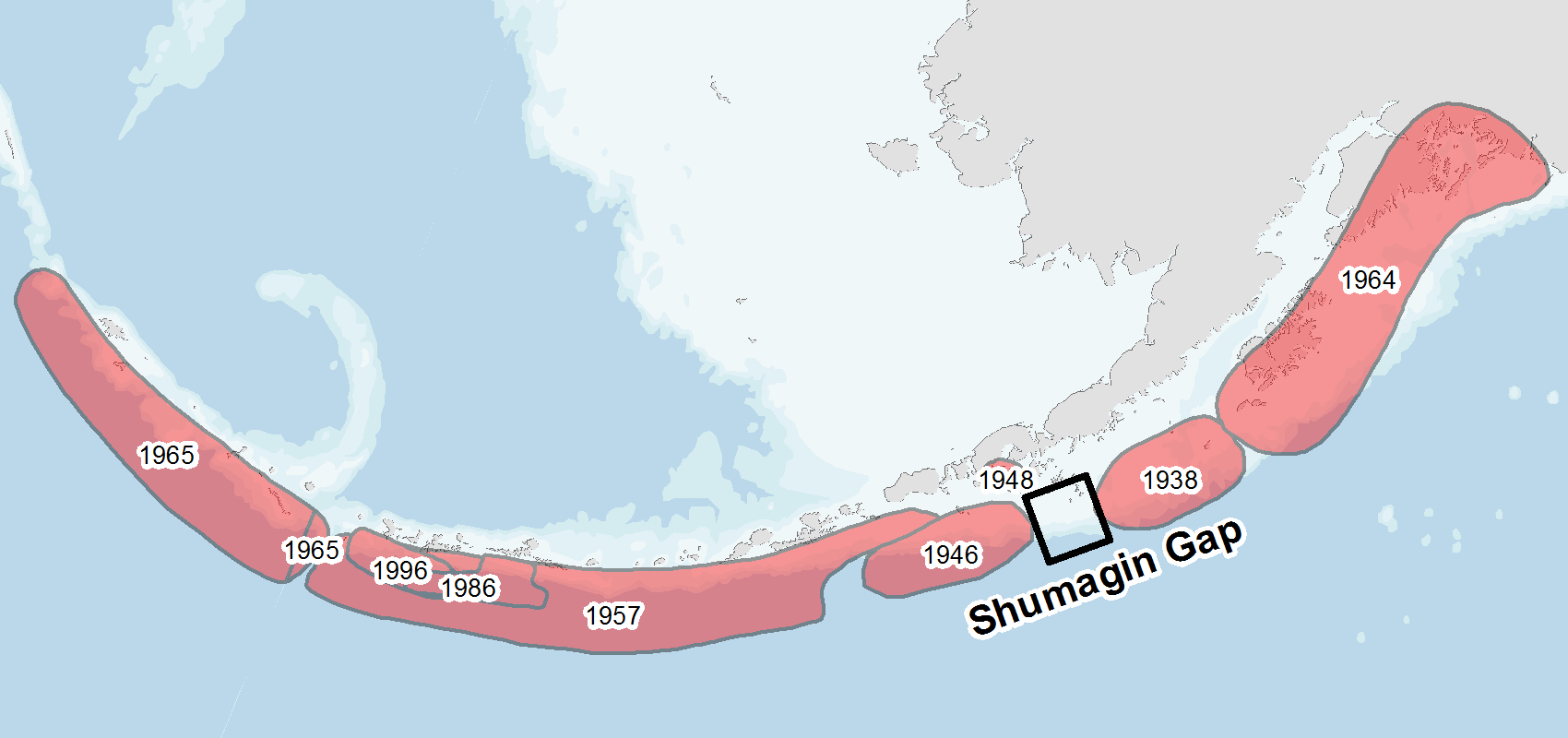Major 2020 Alaska quake triggered neighboring 2021 temblor
Rod Boyce
907-474-7185
May 4, 2022
A study of two powerful earthquakes in adjacent areas off the Alaska Peninsula in 2020 and 2021 shows a connection between the two. It also suggests they may be a part of an 80-year rupture cascade along the fault.
The research was published today in the journal Science Advances in a paper jointly led by University of Alaska Fairbanks Geophysical Institute associate professor Ronni Grapenthin and Michigan State University assistant professor Julie Elliott. UAF postdoctoral researcher Revathy M. Parameswaran is among the four co-authors.

This image from the research paper shows the Simeonof 2020 earthquake slip model contours in black. Chignik 2021 earthquake slip contours are shown in purple. Outlines for contours of the two updated 1938 slip model estimates are shown in light and dark blue. Red outlines show rupture areas for major historic earthquakes. Yellow stars show epicenters of magnitude 7-plus earthquakes over the past century.
The researchers also conclude that the two deep earthquakes on the Aleutian-Alaska megathrust fault, where the Pacific plate is sliding beneath the North American plate, may have brought shallow portions of the fault closer to failure.
They add that their research will help scientists better understand stress transfer and earthquake triggering in the region and in general.
“One large earthquake increases the stress on the neighboring part of the megathrust fault. This patch then ruptures and increases the stress on the next patch in the fault, like delayed dominos,” Grapenthin said. “And that's what we're seeing here.”
The first of the two major quakes, known as the Simeonof event, occurred July 21, 2020. It registered at magnitude 7.8, struck near the Shumagin Islands south of the Alaska Peninsula and ruptured westward.
The second quake, the Chignik event, occurred just over one year later on July 28, 2021. It registered at magnitude 8.2, was located south of the Alaska Peninsula and northeast of the Simeonof quake and ruptured eastward.
The two quakes and their aftershocks occurred in the Shumagin Gap, a spot near the Shumagin Islands in a known band of historical ruptures. That 1,900-mile subduction zone, where the Pacific tectonic plate slides under the North American plate, starts at the tip of the Aleutian Islands. It continues along the south side of the islands and the Alaska Peninsula, curves upward across the Kenai Peninsula and encompasses the Anchorage area and Prince William Sound.
No major earthquakes had been recorded in the Shumagin Gap, a space about 100 miles long in the subduction zone, until the 2020 and 2021 quakes.
“This could be a case study to understand how adjacent earthquake patches could be activated by a significant release of energy that has accumulated through plate motion,” Parameswaran said.
The researchers studied data to assess the impact of the stress changes caused by the 2020 Simeonof quake, particularly as they might relate to the Chignik quake’s rupture site.

Map shows location of the Shumagin Gap, the region where the 2020 Simeonof and 2021 Chignik earthquakes occurred.
Modeling the Simeonof quake's stress buildup shows that the Chignik hypocenter, the location inside the earth at which an earthquake rupture begins, is embedded in an area of increased stress change, consistent with what scientists know about how earthquakes are triggered.
The work also indicated some notable areas of “very high” stress loading of the fault, especially in the shallower regions of the model fault plane. That area didn’t rupture during this earthquake, according to the research paper.
The researchers added that the two earthquakes may be part of an 80-year cascade of large subduction earthquakes along this major plate boundary and that the cascade has now concluded, with the most recent large event prior to the 2020 Simeonof quake being the 1965 magnitude 8.7 earthquake off the Rat Islands in the Aleutian Chain.
Prior to 1965, five earthquakes of magnitude 8 or greater occurred within 30 years from the farthest Aleutian Islands to Southcentral Alaska.
“In the concept of cascades, the entire Aleutian-Alaska megathrust has now ruptured and released most of the stress that has accumulated since the onset of that most recent cascade,” Grapenthin said.
ADDITIONAL CONTACTS: Ronni Grapenthin, 907-474-7286, rgrapenthin@alaska.edu; Revathy M. Parameswaran, rmparameswaran@alaska.edu.
148-22


